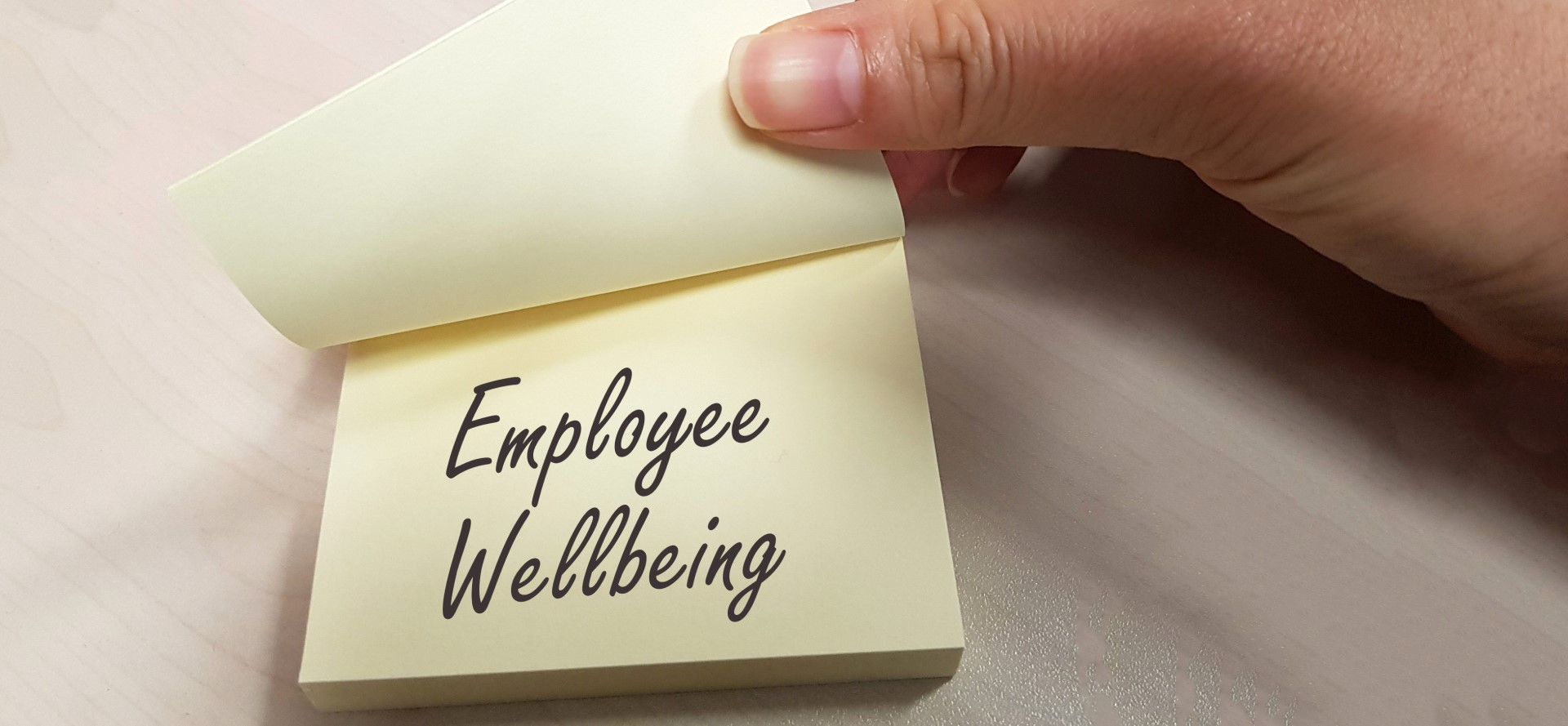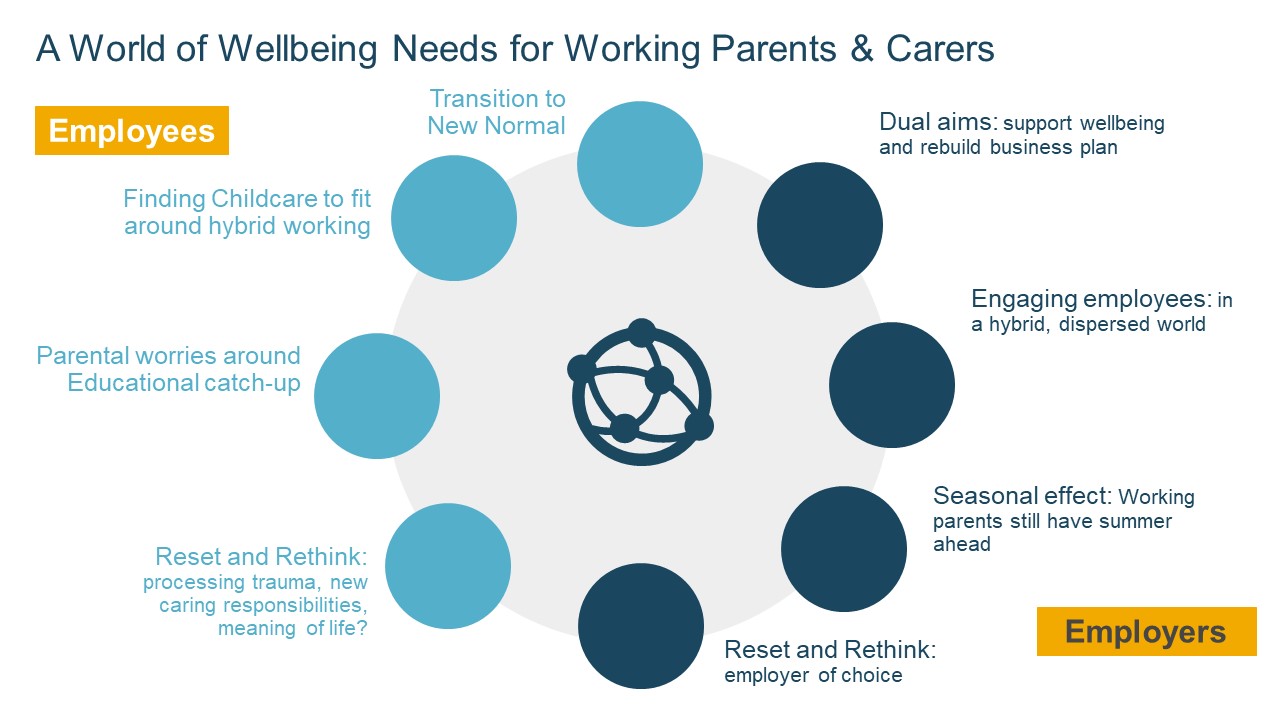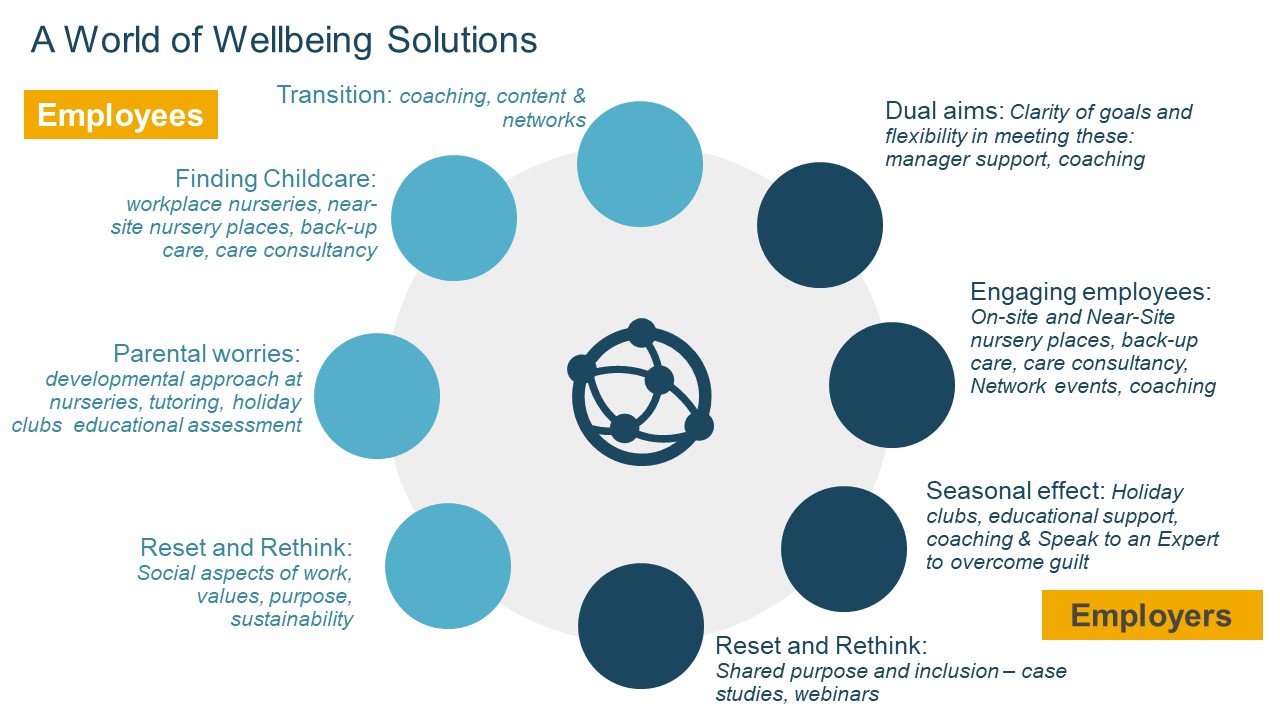Wellbeing: Practical Approaches and Deeper Appreciation

Wellbeing: Practical Approaches and Deeper Appreciation
Jennifer Liston-Smith, Head of Thought Leadership
There is a huge opportunity, and need, to treat the next phase as a new start and a new way of working, and not simply a sense of staggering on from our ‘survival’ state of the last year-and-a-half.
Wellbeing is rightly a focus among all the employers we work with, who are embracing this new phase. Let’s take a look here at two angles on wellbeing:
- Some practical tools that work with the immediate needs and concerns of this phase.
- A look at some of the deeper themes behind the Reset and Rethink
1. Wellbeing Tools for the next phase
The concerns
Right now, leading employers are paying close attention to this time of transition and also to wellbeing. The circles below show some of the current concerns for employees in the paler blue and for employers in the darker blue.

Starting at the top with these pairs of concerns
1. Employees and their employers are focusing on this phase of transition out of pandemic lockdowns and into new ways of hybrid working and we need to treat this as a change management project, not just a continuation of pandemic working
2. Employers want to make this next phase engaging, to rebuild culture and emphasise inclusion, for all employees. For those with family responsibilities, and especially working parents, there is also a practical drive to find care solutions that work for their new working lifestyles.
3. Connected to that, everyone is aware – employers and employees – of the pressures parents have faced, their concerns about educational catch-up and that the summer is always a time when there’s a difficult care juggle. When school’s out, that time is always longer than the annual leave working parents can take. So, for employers, it’s a time to be mindful that this is not the optimum time to secure new ways of working. It’s another phase.
4. And finally that sense of ‘reset and rethink’ that we’re hearing repeatedly in the media, in research, in conversations with employers, with colleagues. For some employees, there is a re-evaluation of career aims and direction, a reconsideration of what their work role is all about; for employers there is an opportunity to be an employer of choice by paying attention to the right things such as culture, inclusion, trust.
The Tools for Support
We’ve found that employers want to tackle these concerns directly, addressing any practical help they can provide as well as acknowledging the emotional and wider aspects of wellbeing. For those areas of concern, we have been working alongside employers in the ways shown below, and more.

- For the transition to remote ways of working during the pandemic and now forward into hybrid working, we have been providing coaching, content and also group events to individuals and their managers. We’ve also played our part as a partner to our clients in sharing best practice advice and supporting planning. As ever, we’ve continued to support initiatives such as buddy schemes for new returning parents for example.
- We’ve done a great deal in the area of help with finding care of course, from care advisors helping individuals navigate the options through to our staples of workplace nurseries (making office collaboration places attractive with childcare on hand), near-site nursery places in our community nurseries (more employers are branching into partnerships with our local community nurseries to provide childcare nearer home-based offices) and back-up care which can be used quite flexibly to support unexpected changes in work schedules. Providing access to care solutions is part of enabling people to be present at work, as well as supporting work-life balance and alleviating stress. It’s about staff being well, supported and at work. And of course, again, coaching and events have a role here, to build culture and capability for new ways of working.
- We’re busy every year supporting with back-up care through the summer holidays including access to summer camps and of course virtual summer programmes. We’ve also been active in helping with educational catch-up, described a little further here including some clients experimenting with enabling employees to convert their back-up care subsidy into tutoring to help with educational catch-up.
- An awareness of the great ‘reset and rethink’ has led many clients to draw further on our coaching, content and events for their employees. We have also worked hard to host best practice networking events and to share case studies as well as speaking at conferences. This, more than ever, is a time to share experience, from simple tips to strategic insights.
2. Reset and Rethink: a meaning of life moment
Having outlined some of the practical approaches that help at this time, such as care solutions, this is also a moment to pause and take account of the deep emotional themes arising from the pandemic, and the sense of shock – or disengagement – many people may be left with, showing why a wellbeing focus is so needed, and so much discussed. There are some key themes to be aware of: languishing, post-pandemic stress and grief are among them.
Languishing
Adam Grant wrote in the New York Times in April 2021: There’s a Name for the Blah You’re Feeling: It’s Called Languishing. The term comes fromsociologist Corey Keyes. Grant explains: “Flourishing is the peak of well-being: You have a strong sense of meaning, mastery and mattering to others. Depression is the valley of ill-being: You feel despondent, drained and worthless. Languishing is the neglected middle child of mental health... it may be the dominant emotion of 2021. It’s the void between depression and flourishing — the absence of well-being…”
Adam Grant points to the concept of “flow” as an antidote to languishing. “Flow is that elusive state of absorption in a meaningful challenge … where your sense of time, place and self melts away. During the early days of the pandemic, the best predictor of well-being … was flow. People who became more immersed in their projects managed to avoid languishing and maintained their pre-pandemic happiness”.
Grief
Summing up the different mood last year, Scott Berinato’s interview with grief expert David Kessler described the pandemic response as collective grief. That Discomfort You’re Feeling Is Grief has been one of the most-read HBR articles. The piece explained how the classic five stages of grief (denial, anger, bargaining, sadness, acceptance) apply to the pandemic, and the practical steps we can take to manage the anxiety. Kessler also talks about “a sixth stage of grief: meaning. After acceptance, he says, we will find meaning in the hard-to-fathom events and we will be stronger for it.”
As well as an overarching sense of loss, there has been very tangible and real grief for so many families. In Bright Horizons own recent webinar on Grief & Loss for client employees, host Emma Willars and therapist, Nike Siffre offered tools and insights for building a support network to help with bereavement. One popular framework was Richard Wilson’s (1992) concept of the Waterfall of Grief: "Imagine you are sailing along in a small boat on the river of life. All of a sudden something catastrophic happens to you... Grief feels like your boat has fallen over the edge of a waterfall and you are suddenly plunged into the whirlpool below. The whirlpool carries you round and round, visiting the same emotions time and again, with the occasional respite in the shallows and the risk of being cast against the rocks. The time spent in this period of disorganisation will vary and some who have been washed up on a bank will choose to stay there. But when the time is right for reorganisation, the ‘River of Life’ leads away from the whirlpool to calmer waters. Your boat is patched up and you sail off on a new river”.
Insights like this, that resonate for people and somehow make sense of grief can bring us together and support coming to terms with grief due to bereavement as well as a broader sense of grief over lost opportunities, family occasions, life stages, and more, that many are feeling, including those now living with long covid or with new caring responsibilities. Some feelings of grief may only now be surfacing as we move – hopefully – out from more intense, urgent phases of crisis.
Post-Pandemic Stress
In addition to long Covid, the other health shadow cast by the pandemic is the post-traumatic one. Natasha Hinde weighed up, in HuffPost, whether we actually need a new name for this such as Post-Pandemic Stress Disorder. Some will now be realising they are in a state of shock about what we just experienced, particularly those working on the front line and in essential services, as well as those who have worked to balance parenting and caring responsibilities with work and other demands through different phases.
Leading employers are recognising this and finding ways to encourage people and teams to build social support into new ways of working as well as providing access to expert help. Where people find meaning and purpose in their work and their ways of working, it can help in moving through to new phases and away from the shock of our recent times. Coupling that sense of purpose with specific practical and emotional support is vital.





